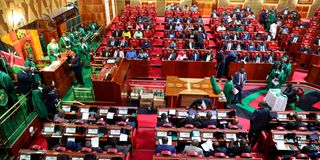Cabbienomics and Kenya Kwanza budget proposals

After more than five years of back and forth, The National Transport and Safety Authority (Transport Network Companies, Owners, Drivers and Passengers) Regulations, 2022 were tabled in the House on October 4, 2022.
Like many Kenyans, I spent Madaraka Day kicking back among friends, pondering the fate of our beloved nation. One friend, whose identity I must protect by calling him Chakademus, posed a rather profound question: What is the impact of the Finance Bill, 2023 on taxi-hailing services and rides?
“I always read your column,” he offered, and “liked the earlier articles on cabbienomics!”
Encouraged, I pledged to do some quick analysis, so here we go.
For economists, taxi-hailing services are a particularly attractive area of study because they come close to ideal conditions for perfect competition. But is the competition between the hailing apps or the drivers?
The competition is at both levels. The actual technology is rather easy to duplicate and the apps are increasing rapidly. In smaller towns like Nanyuki and Nyahururu, local hailing apps rule. But the new entrants struggle to build a critical mass, as the markets are small.
To stay ahead, the older, more dominant apps have to continue improving features. In some markets like New York, they are doing deals with traditional taxi companies.
In our cities, the hailing apps are waging a vicious price war. For instance, a leading service has been offering customers hefty discounts in Nairobi. Two new entrants have been advertising heavily to attract subscribers. The older, dominant hailing services are also heading out of the city to large towns like Kakamega. Some drivers are on more than one platform at the same time.
All this competition has led to sharply declining fares. Drivers are opting for smaller cars for fuel economy. It has also encouraged owners and drivers to convert petrol vehicles to gas as the latter is cheaper. All hailing apps are now paying more attention to boda bodas.
The taxi-hailing apps have brought disruption to the traditional taxi business, making it possible for many more people to use taxis. And as can be expected, a fair amount of controversy has erupted everywhere, with regulators trying to play catch-up. Kenya is no different.
After more than five years of back and forth, The National Transport and Safety Authority (Transport Network Companies, Owners, Drivers and Passengers) Regulations, 2022 were tabled in the House on October 4, 2022. An early draft of the regulations surfaced around 2019. The draft made its way through numerous parliamentary committees, including Labour, Transport and Delegated Legislation. The NTSA and their parent ministry went through many iterations, including a change in the title of the legislation.
External consultant
Lobbying was intense for the regulations to be finalised as elections approached. Some clever technocrats even suggested hiring an external consultant to review and perfect the regulations. They even identified the Horn of Africa Gateway project as the source of funds to pay the external consultants! It seemed the delays would never end. Finally, reason prevailed and the regulations were gazetted on June 20, 2022.
However, one major bone of contention is the maximum commission that a driver should pay the hailing app company. The drivers claimed Rwanda and Ghana had capped the commissions at 10 per cent and wanted Kenya to follow suit. The owners of the apps threatened job losses if a cap was introduced. In the end, the regulations capped the commission at 18 per cent. But to date, some companies are still charging up to 25 per cent.
The regulations gave no recognition of drivers’ representation. In fact, the regulations are completely silent on any security or protection for drivers as workers. The regulations do not address the security of the driver, focusing instead on that of the passenger.
Data handling is rather poorly addressed, though both the driver and the passenger have to provide significant and sensitive data such as real-time location.
Finally, the regulations also fail to address the tax obligations of the hailing app companies, while at the same time exposing the drivers to overtaxation and exploitation by the apps.
If passed, the Finance Bill 2023 will increase the cost of taxi rides and squeeze the margins of the drivers. It will do so through higher VAT on fuel, higher excise on mobile money transfers and turnover tax.
We pay for the taxi rides by sending money to the driver. The excise tax on mobile money transfers is going up from 12 to 15 per cent. For a Sh500 ride, the customer will pay a Sh15 excise tax, so the total outlay will be Sh515.
The Finance Bill proposes to double VAT on fuel to 16 per cent. This will increase pump prices by Sh10-12 per litre of petrol. This will likely be borne by the driver unless the hailing companies revise their pricing models. The most confusing is the turnover tax. First, who should pay? The app company, the owner of the vehicle, or the driver? The burden will likely fall on the drivers.
@NdirituMuriithi is an economist





